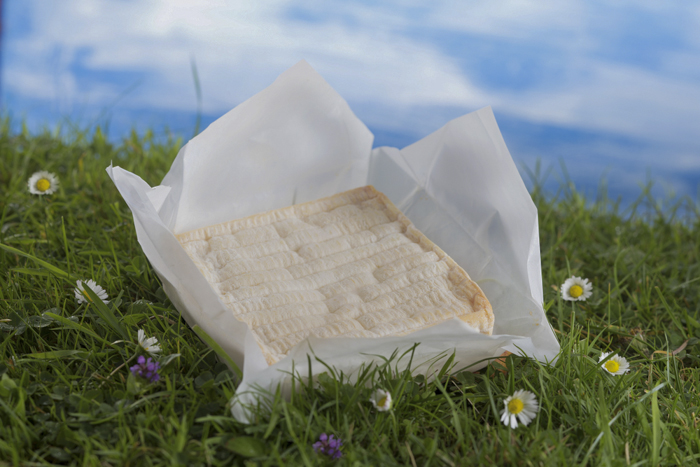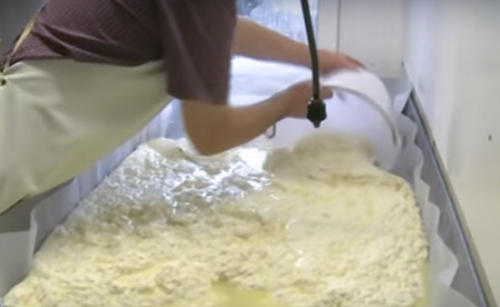Pont l'Eveque Info
Pont l'Eveque from Normandy France
With Pont l' Eveque we travel to Normandy France for on eof the cheeses in their triple crown.
Pont l' Eveque is perhaps the oldest of the Normandy cheeses. It's a beautiful mix of bloomy rind and washed rind aging, falling right between the Camembert and Livarot cheese we have profiled previously.
If you can find it here in America, it will be in a small square box with the cheese surface appearing as a white to cream with underlying tan/rose peeking through.
Once you cut into it, you will find the edges have broken down more than the center and give you a contrasting flavor of that sweet gooiness of Camembert near the edges and a firmer and brighter acid as you approach the center.
THis is a great flavor combo in the mouth. Less mushroomy in the crust than the Camembert, but this allows you to focus more on the milky goodness of the cheese.
The History of Pont l'Eveque
The roots of Pont-l’Évêque are believed to have been established by Cistercian monks in the 12th century. In 1225, it was written in the Roman de la Rose, "Good food always included Angelots cheese for dessert". In those days it was known as Angelot or Augelot in old writings, the word Angelot comes from the name of an English coin (the Angel). Back then, the cheese was used as a means of barter, payment and tax.
The "Angelot" or "Augelot", referenced to the Pays d’Auge, defined a fat, cylinder-shaped cheese the size of a Camembert.
It is only in the 18th century that the name Pont-l’Évêque took its square shape, in order to differentiate with the Livarot.
For several decades after the French Revolution, the cheese was called Pont Chalier to eliminate any reference to the Catholic Church.
In 1970, the Syndicat des Fabricants de Pont-l’Evêque et Livarot applied for the recognition of a Designation Origin, which met approval in 1972.
The Process of Making Pont l'Eveque
Grass is favored to feed the cows, and grazing is mandatory for at least 6 months during the year. Concentrate feed - other than forage - is restricted to 4000 lb. per cow per year. Finally, particular attention is given to the quality of the feed, following a good list of authorized feed.
In 2017, in order to provide enough time for farmers to adapt, at least half of the dairy cows shall be of Normande breed. I am lucky enough here to have access to a herd that is 25-30% Normande mixed with Jersey.
The milk is collected by dairies and kept cold as it undergoes rigid health and safety tests. In the cheese-making facility, when using raw milk, it is left to rest for at least 26 hours in order to help it develop its natural dairy bacteria, but the time between milking and renneting shall not exceed 48 hours in the farm and 96 hours in total (72 hours in the case of production from raw milk).
It takes 3.5 liters of milk to produce a 360 grams Pont-l'Évêque and a month and a half in order to make it wholly creamy.
The curd must be successively cut, kneaded and then drained for a drier curd going into the molds.
During affinage, the cheeses must be washed, brushed and turned with a focus on developing the desired mix of yeast and mold communities on the surface. The temperature and moisture are well controlled to avoid a ripening that is either too fast or slow.
Pont l'Eveque Variations in Style
Its rind is mostly white, with some buff to reddish coloration. The interior is soft to semi-soft and supple, with a few small eyes and a uniform butter color. Depending on the age and condition of the cheese, the aroma can be robust, like a well-used cow barn but in a good way. Its good to be reminded of where your food comes from.
To meet regulations, the milk must come from a controlled area around the village of Pont-l'Évêque, extending to the départments of Calvados, Eure, Manche, Mayenne, Orne and Seine-Maritime.
The resulting cheese must be one of three sizes:
- Petit - 8.5-9.5 cm square, and a minimum of 85g of dry matter
- Demi - 10.5-11.5 cm by 5.2-5.7 cm, with a minimum of 70g of dry matter
- Grand - 19–21 cm square, with a minimum of 650g of dry matter
The affinage lasts at least two weeks after production, though most are left for over six weeks.
The length of ripening will determine the final texture, flavor , and aroma of the cheese, from young and mild to an aged cheese with aggressive aromatics and flavors and creamy texture. It is a matter of personal taste, but the former is more in tune with today's taste for the younger generation. Personally I go for a ripeness in between.
The cheese is around 45% fat as a percentage of dry matter and is manufactured throughout the year.
Regulations currently allow either pasteurized or unpasteurized milk to be used for its manufacture.


































